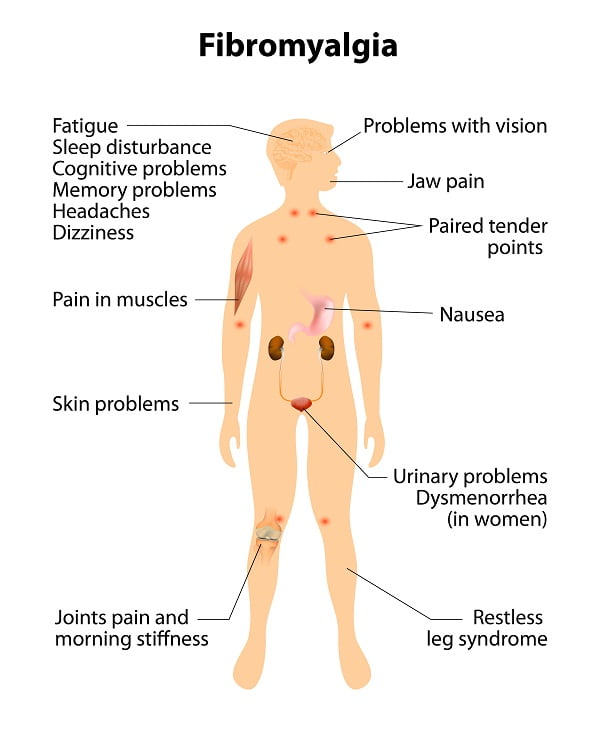What is fibromyalgia?
Fibromyalgia is a condition in which the patient suffers from musculoskeletal (muscle and skeletal) pain accompanied by fatigue, sleep, memory and mood issues. It is a condition related to the disorder of pain processing due to abnormalities in how pain signals are processed in the central nervous system.

How common is fibromyalgia?
According to a study, about 2-8% population is affected by this disease. According to a survey, women are more likely to develop fibromyalgia as compared to men. Fibromyalgia is said to amplify painful sensations by affecting the way brain processes signals. When a person has fibromyalgia, the person may have more cells that carry the pain signal as compared to normal people. This means the volume of pain is increased.
How does fibromyalgia occur?
The onset of condition begins with physical trauma, surgery or infection. With time, symptoms accumulate and get worse.The brain is the first organ to know that the person’s body is in pain (or trauma). Nerve signals travel from the point of pain (stress) to the brain through the spinal cord. As the injury heals, the pain goes away and so does the sensation.
The person suffering from this condition feels the pain all over his/her body without being injured or sick. Moreover, the pain doesn’t go away. Some doctors suggest that the reason behind this is the way spinal cord and brain handle the pain. The main cause of this condition is still unknown: however, a combination of genetic and environmental factors like psychological stress, trauma and certain infections are said to be the involved in the onset of this condition. The pain appears because of “central sensitization syndrome”. Other symptoms are:
- Tiredness and fatigue
- Sleep problems
- Memory issues
Medications can help relieve the symptoms but there is no exact cure for this condition. Exercise, relaxation and stress-reduction measures also may help.
There are no specific diagnostic tests for fibromyalgia. As the symptoms are subjective, the disease is often misdiagnosed. Thus, diagnosis is done by ruling out potential causes and verifying the set of symptoms present. The treatment of this condition can be bit difficult. Physicians often recommend getting sufficient sleep, exercising regularly and eating a healthy diet.
Often drugs like duloxetine, milnacipran, or pregabalin are also suggested. Though, the condition may be chronic; but does not result in death or any other tissue damage.
Classification and types of fibromyalgia
Fibromyalgia is classified on the presence of chronic pain and pain localized in areas like shoulders, neck, lower back, hips and other areas. According to a report published in 2007, the condition can be classified into following main types:
- extreme sensitivity to pain but no associated psychiatric conditions
- fibromyalgia and comorbid, pain-related depression
- depression with concomitant fibromyalgia syndrome
- fibromyalgia due to somatization
About 20-30% of people with rheumatoid arthritis and systemic lupus erythematosus (SLE) also suffer from bone fibromyalgia.
What are the symptoms of fibromyalgia?
The condition is known to affect areas of tenderness or the trigger points. A trigger point is the area in the body where even a light pressure will cause pain. The main defining symptoms of fibromyalgia are:
- Widespread pain
- Fatigue
- Sleep deprivation
- High pain towards tactile pressure (allodynia)
- Tingling of the skin (paresthesias)
- Muscle spasm
- Nerve pain
- Weakness in limbs
- Palpitations
- Bowel disturbances
- Muscle twitching
- Cognitive dysfunction (fibrofog)
- Restless legs syndrome
- Bowel and bladder issues
- Numbness
- Tingling
- Sensitivity to noise, light and temperature
- Tension
- Anxiety
- Headaches
People suffering from this condition also suffer from memory issues like:
- Short-term and long-term memory loss
- Short term memory consolidation
- Impaired speed of performance
- Inability to multi-task
- Cognitive overload
- Diminished attention span
In addition, the condition is associated with depressive symptoms and other symptoms like:
- Myofascial pain syndrome (chronic myofascial pain)
- Non-dermatomal paresthesias
- Interstitial cystitis
- Dermatological disorders
- Myoclonic twitches
- Symptomatic hypoglycemia
What is fibromyalgia flare up?
A sudden increase in the intensity and number of fibromyalgia symptoms is called ad fibro-flare up. It may last for one or two days. In severe cases, it may continue for a week also. Two prominent features of fibro-flare are:
- Increased fatigue
- Increased body pain
These conditions are also accompanied by restless sleep and digestive issues. The condition needs immediate consultation as it affects daily routine of the person suffering.
What are the risk factors for Fibromyalgia?
The cause of fibromyalgia is not known yet. Many things could cause the body to signal the pain in a different way. Different people report different factors or conditions that trigger their disease symptoms. This includes following:
Genes
The condition is said to run in families and is thus related to the genetic makeup of the person. Parents may pass on the genes to their offsprings that can make them more sensitive towards pain.
Emotional/physical abuse
According to a research, children who are (or were) abused emotionally or physically are more likely to get this condition. The harassment tolerated by them makes their brain to change the way it handles the stress and pain.
Gender
Women are more prone to this condition as compared to men. According to researchers, this may be because of the way men and women feel and react towards pain. Another reason could be how society expects them to react towards pain.
Depression
Mood swings and mood disorders in some cases are said to link with fibromyalgia. However, there is no evident proof for this yet.
Post-traumatic stress disorder (PTSD)
Some people develop this mental problem after going through a terrible event like rape, accident or war. Yet no specific evidence is available for linking traumatic experiences with fibromyalgia.
Inactivity
The condition is much more prevalent in people who are inactive physically. Exercise is one of the most common treatments for fibromyalgia.
Other diseases
Other diseases like arthritis or any other infection can raise the risk of getting fibromyalgia.
What are the causes of fibromyalgia?
Why do some people develop fibromyalgia is still not clear. Since a number of contributing factors are involved, the exact cause is not known.
Some major causes are reported as:
- Abnormal pain signal
- Chemical imbalance
- Sleep problems
- Genetics
- Associated conditions
- Other triggers
Abnormal pain signals
Researchers suggest that changes in the way the central nervous system (CNS) processes pain signals all around the body lead to the development of fibromyalgia. This could be because of any changes in the chemicals present in the central nervous system which comprises of the brain, spinal cord and nerves. Changes in this system explain a lot about the hypersensitivity of people for the pain.
Chemical imbalance
Recent developments have found out that fibromyalgia may be caused due to extremely low levels of hormones in the brain like serotonin, noradrenaline and dopamine. As these hormones play important role in regulating mood, appetite, sleep and behavior of a person, any changes in their levels will show abnormal effects.
In addition, these hormones also play a major role in the processing of signal sent by nerves. Sometimes, increasing the level of these hormones with the help of medications will also show abnormal effect. Along with this, any drastic changes in the level of cortisol hormone that is released when the body is under stress may also contribute to fibromyalgia.
Sleep problems
Disturbing sleep pattern may be a cause rather than a symptom of fibromyalgia. Fibromyalgia may prevent people from going into a deep sleep which ultimately causes fatigue and extreme tiredness. People with this condition who cannot sleep properly have a high level of sensitivity towards pain, which suggests that sleep deprivation is also related to fibromyalgia.
Genetics
Genes and genetics also play a significant role in the development of fibromyalgia. Parents suffering from this condition are more likely to transfer this condition to their offsprings. Genetics could explain a lot about various triggering conditions that onset fibromyalgia.
Associated conditions
In addition to the above-mentioned triggers, following are some other conditions that may result in fibromyalgia:
- osteoarthritis (damage to the joints that causes pain and stiffness)
- lupus (the immune system mistakenly attacks healthy cells and tissues in various parts of the body)
- rheumatoid arthritis (the immune system mistakenly attacks healthy cells in the joints, causing pain and swelling)
- spondylitis (pain and swelling in parts of the spine)
- temporomandibular disorder (TMD) (a condition that can cause pain in the jaw, cheeks, ears and temples)
Other triggers of fibromyalgia
Any stressful event like physical stress or emotional stress can also trigger fibromyalgia. Following are the possible triggers:
- Physical injury
- Viral infection
- Giving birth to child
- Surgery or operation
- Relationship breakdown or being in an abusive relationship
- Death of closed one or loved ones
Fibromyalgia Diagnosis: How is fibromyalgia diagnosed by doctors?
The diagnosis of fibromyalgia is not easy because of its overlapping symptoms with conditions like rheumatoid arthritis and lupus. Another reason is it being a variable disorder as symptoms can vary from person to person.
Following are the diagnostic methods and tests used by doctors:
- Medical History
- Fibromyalgia Scoring System
- Tests for other eliminating other conditions
Medical History
In order to diagnose the condition, a doctor will go through the patient’s medical history and will ask questions about anyone in the family having the same condition. The doctor will inquire about symptoms and their specificity.
Generally, patients are asked to maintain a record diary of pain and location of pain along with intensity. The doctor may still perform a physical examination to rule out other possible diseases. The doctor may tell after some tests and medical history examination that you have fibromyalgia if he/she is familiar with the condition.
The first step in the diagnosis of any disease is an analysis of medical history. Even after ruling out the tender points, the doctor will still ask questions about the tender points where it hurts. There is no single test that is used for the diagnosis of this condition. The basic signs and symptoms that are used for the initial diagnosis are:
- Persistent widespread pain (both sides of upper body)
- Stiffness
- Fatigue and non-refreshing sleep
- Cognitive difficulties
Fibromyalgia Scoring System (FSS) and fibromyalgia severity scale: What is widespread pain index (WPI)?
The doctor may use a two-part process if he/she is unable to confirm fibromyalgia. One part involves the widespread pain on both the side of body above the waist while the other involves the intensity of the symptoms.
The doctor may also ask 19 specific places where the patient had pain. This includes arms, legs, back, jaw and neck. This is called as “widespread pain index” (WPI). Scoring is done for pain in all the mentioned parts. The severity scale measure:
- Fatigue
- Non-refreshing sleep
- Thinking problems
The Severity scale ranges from Zero to Three:
- “Zero” indicates no fibromyalgia
- “One” indicates a mild condition which comes and goes.
- “Two” indicates moderate condition which is usually felt by person
- “Three” indicates severe condition that affects normal life of person
What are the tests for eliminating other conditions?
Before making an official fibromyalgia confirmation, the doctor rules out other conditions that may have similar symptoms. To eliminate other possibilities the doctor may perform tests like:
- Complete Blood count
- Antinuclear Antibody Test
- Calcium/ Phosphate level
- Creatine Phosphokinase test
- Genetic marker tests
- Test for liver and kidney function
- Thyroid tests
- Rheumatoid factor test
- Vitamin D
The fibromyalgia diagnosis may be a bit time-consuming process. The doctor may repeatedly ask similar questions. The tests may be sometimes repeated to ensure correct diagnosis as the symptoms look like general health problems. With the right treatment, most of the people suffering from it lead a normal active life.
What is the treatment of fibromyalgia?
The complete treatment of fibromyalgia is not possible. Thus, it is more important to find a doctor that can help the patient in pain management and in leading a normal life. Treatment may require a team effort from patient and his/her doctor. In addition, a physical therapist and other healthcare providers are also involved.
Following are the treatments involved:
- Medications
- Getting proper sleep
- Psychological support
- Regular exercise
- Changes at work
- Other options
- Healthy diet
- Warm Water Therapy
- Massage with essential oils
Medications for fibromyalgia
Three medicines are approved by Food and Drug Association (FDA) to treat this condition. These are:
- Pregabalin (Lyrica)
- Duloxetine (Cymbalta)
- Milnacipran (Savella)
Other medications are being developed by the researchers and may get approval from FDA in future. In addition to these drugs, the doctor may suggest low-dose antidepressants and non-narcotic pain relievers to improve the symptoms.
Sleep well
Getting an adequate amount of sleep in the night can also help in relieving the symptoms. The patient should keep regular sleep habit and try sleeping at the same time even on the weekends and vacations.
Caffeine and late night alcohol consumption should be avoided in the late night or evening. The patient should also take out some time for exercise to improve the night sleep. However, exercising 3 hours before bedtime is not highly recommended.
Following are some tips to get a good refreshing sleep:
- Do relaxing activities
- Take a warm bath to relax your body
- Give rest to your eyes by closing them
- Avoid daytime naps
- Keep your bedroom dark and quite
- Use same bed for sleeping
- Avoid spicy foods and beverages before bedtime
- Avoid watching late night news, reading novels and working on laptop
Psychological support
Living with a chronic painful condition can be sometimes hard for the person. The person may need counseling sessions and regular moral support from the near-dear ones. Trained counselors can help the patient understand his/her situation in a better and more acceptable way.
Staying active
The pain and fatigue from the disease may make regular exercise and other daily activities difficult. Nevertheless, it is important to be active physically in such conditions. Research has shown that regular exercise and physical activities can be one of the effective treatments for fibromyalgia.
People with the severe condition may find it quite hard to exercise initially due to pain but with time, the condition gets better. Walking and other gentle exercises can be beneficial. They also help build up endurance and intensity slowly.
Changes at work
Big changes are required for working people who are diagnosed with fibromyalgia. Some people may need to cut down their working hours. Sometimes patients may need to switch to less demanding jobs. If a person feels uncomfortable with their current sitting or standing position, they can talk to their employer about it. There are federal laws that protect the rights of the person with disabilities.
Other treatment options and therapies for fibromyalgia
Other therapies are available that can help a patient with this condition live a normal life. Talking to the doctor about all the options available can help. Following are some of them:
- Osteopathic manipulation
- Physical therapy and massage
- Myofascial release therapy
- Water therapy
- Light aerobics
- Yoga
- Applying heat or cold
- Relaxation exercises
- Aromatherapy
- Cognitive therapy
- Biofeedback
- Herbs
- Nutritional supplements
Healthy diet
According to a survey, people reported that they feel better by avoiding certain foods. However, no specific diet influences fibromyalgia. It is important to have a healthy diet regime as it gives energy and makes you feel better.
Warm water therapy
Some people may find relief with warm water. Plenty of options are available like water aerobics and hot water baths to relieve the intensity of pain felt by fibromyalgia patient. Stretching and relaxing in a hot bathtub can also help with the condition.
Massage with essential oils
Massages are not considered ideal treatment but still, they help with the pain and relaxing body. It can relieve stress and severity of the pain. Using essential oils for massage can give a calming and soothing effect.
Reducing stress
The symptoms of fibromyalgia get worse with emotional and mental stress. The flare-ups are common in people who are constantly under stress. Eliminating the source of stress will help the patient in a way. Fibromyalgia patients must learn to cope-up techniques for minimizing the stress on mind and body. Following are some stress buster methods that can be adopted:
- Meditation
- Relaxation
- Acupuncture
- Deep breathing technique
Prevention of Fibromyalgia: How can you prevent fibromyalgia?
In U.S.A only, about 5 million people suffer from fibromyalgia. The risk can be cut out by incorporating few changes in the lifestyle. People should try going towards healthy habits.
Following are some tips to prevent fibromyalgia:
- People should eliminate processed foods, white flour and white sugar from the food. These products do not give any considerable nutrition to the body and with time damage the digestive system. This generally makes a person obese.
- To maintain nutrition and balance in the body, a person should include unprocessed foods in their diet. Unprocessed food like vegetables, whole grains and legumes contain protein and carbohydrates that help in building an internally strong body.
- Avoiding overly oily and greasy foods is also of great help. Cold drinks, alcohol and uncooked food must be avoided.
- The person should stop drinking sodas, as they are acidic in nature and loaded with chemicals and sugar.
- Exercising regularly is also beneficial. Find an exercise that you enjoy, for example, cardiovascular, yoga, swimming and stretching.
- Taking a walk everyday helps in maintaining a healthy regime.
- Avoid taking the stress and overburdening yourself. Try to live in the moment and enjoy the life.
- Practice acu-massage to relax the body and relieve the pain.






